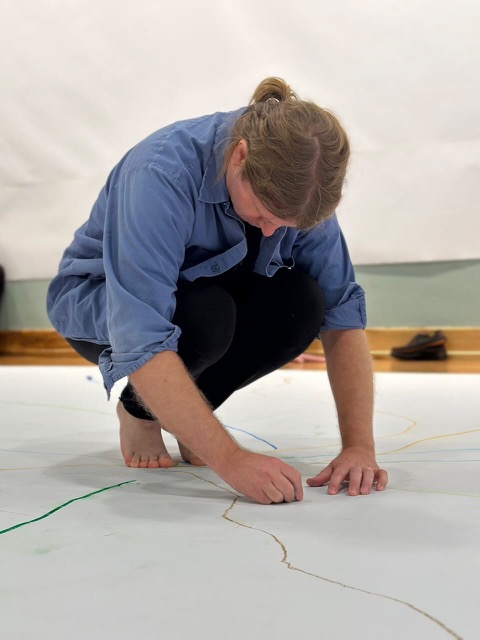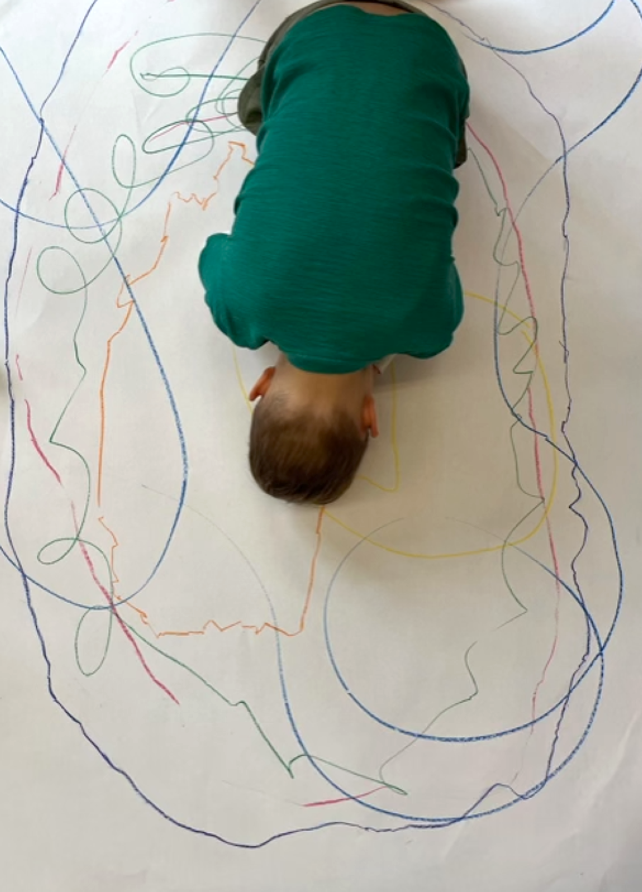Movement, Music and Representation
Mark Sorvari
Professional musician, performer, teacher, and event curator, Mark Sorvari is the Director and Lead Instructor of Playing With Music, which began in 2015 as a vehicle to foster, teach and share inspiring and uplifting music and creative movement experiences for young children and their caregivers. Mark has worked in early childhood music education since 2010 and has experience working with children following the Reggio Approach and is certified in Orff-Schulwerk (music education pedagogy) and Music Together.
Seven years ago, I discovered the teaching duo Segni Mossi, meaning “Leave A Trace” in Italian, while researching music and creative movement in a Reggio-inspired setting. Their interdisciplinary approach prioritizes experimentation as a working method, emphasizing the creative process over the final outcome. The Reggio-Inspired Network of Minnesota Education Scholarship enabled me to attend the Segni Mossi Pink & Red training workshops in October 2023. These workshops explored the interaction between dance and graphic signs, using paper, oil pastels and the human body.
The Segni Mossi workshops not only provided illumination but also inspired answers to ongoing questions within a Reggio-inspired context. How can educators facilitate cross-domain connections and interweave different competencies within the Hundred Languages? What learning environments stimulate critical thinking and aesthetic feeling simultaneously? How can we advance Malaguzzi’s vision for ateliers to embrace innovation beyond the original visual art template, specifically incorporating music/sound, movement/dance, drama, and poetry? Is the atelier a technique rather than a physical space? If teachers are to become co-creators and co-learners alongside students, is expertise in the Hundred Languages essential or does the lack of expertise open up possibilities brimming with critical thought, creativity, collaboration and communication?
Segni Mossi’s playful approach challenges participants to engage in art within a social setting, stimulating critical thinking and aesthetic feelings simultaneously. The workshops break barriers between language, body, and line, creating a dynamic, exciting environment. Participants explore expressive qualities of body movements and signs, interweaving competencies and viewpoints. Segni Mossi’s goal is to “liberate the sign from representative subordination,” (https://www.segnimossi.net/en/about.html).
In an initial proposal, we spoke our names, added corresponding body movements and transferred that movement to leave a trace with oil pastels on a large sheet of paper affixed to a wall. The transformation from name to movement to visual representation was a very powerful experience as it broke barriers between language, body and line. Additionally, we represented a chosen sign with our bodies in space, allowing it to become three-dimensional, interweaving and making connections between the different languages. Carefully curated music accompanied each experience, creating a beautiful dance and interplay between the human body, mark-making tools, paper, space and our connections to others. The whole process was playful and exciting, and it felt like a performance or a story unfolding right before my eyes.
Fellow educators, many currently working in Reggio-inspired environments, unanimously agreed that such proposals freed them from specific expectations, empowering uninhibited play with materials; no particular expertise or skill sets were required to participate and enjoy these proposals. The environment, materials, and provocations were the basic ingredients. The excitement of watching each participant’s (or group of participants’) creative and cognitive interpretations unravel was added spice! The immediacy and freedom to explore was liberating as it challenged us to move out of our comfort zones.
In another captivating proposal, we embodied the concept of expansion by moving our bodies as though we were seeds sprouting from the soil. This dynamic movement was translated onto a large piece of white paper (approximately 10’ x 10’) on the floor. Beginning from the center with an oil pastel, each of us expanded our body outward, leaving a distinctive trace of movement on the paper. Observing each person’s unique expansion and the remnants of their movements expressed through oil pastel lines, led to fascinating reflections.

During the subsequent discussion, we delved into the role of the observer within the context of the Reggio-inspired approach. It became evident that not only teachers could play this role, but observation also emerged as a crucial aspect of the experience for the children themselves. The act of observation contributed to the visual aesthetics of the proposal, creating an intricate interplay between the lines left on the paper, the body movements, and ultimately, between each individual in the experience.
As these lines organically grew across the paper, so did the connections and relationships between the participants. We forged deep bonds with each other through our interactions with expressive languages in a shared space. In this environment that encouraged freedom of expression without judgment, we found ourselves not only learning about each other but also discovering more about ourselves.
These encounters pushed me to break free from habit, emphasizing that this space was meant for testing theories, experimenting, taking risks and gaining a deeper understanding of the world. The challenges compelled me to be more adaptable and think on my feet in order to foster ever-evolving experiences for children.
Upon returning from the workshop, I began offering Segni Mossi-inspired proposals to children. It became evident that this approach inspired new ways to move their bodies and to have a multi-layered sensorial experience. As they danced, the squiggles and lines left on paper overlapped, creating a beautiful fusion. Children embraced the opportunity to dance their own lines, interpret each other’s circle or scribble, mirroring the collaborative dance of lines on the paper.

Intriguingly, they started imagining pictures formed by the intermingled lines, giving rise to a series of captivating stories. At one early childhood center with high vaulted ceilings, where children had shown curiosity about echoes, I introduced proposals integrating body movement and mark-making as a tool to explore concepts related to sounds, vibrations and echoes, providing an enriching experience for the young learners that deepened their understanding and gave rise to new questions.
After participating in the Segni Mossi workshops, I've gained a fresh perspective on utilizing the Hundred Languages, free from hierarchical constraints or divisions. This approach allows for a fascinating dance to unfold among various expressive languages. Excited about the insights gained, I am eagerly anticipating another series of Segni Mossi workshops scheduled for February 2024 in New York City. I look forward to exploring additional avenues for blending and interweaving the Hundred Languages in my work.